History of Astronomy: Origins, Timeline, Inventions, Discoveries
Astronomy originated in ancient times, with evidence dating back to 40,000 BCE. Early astronomical observations were recorded in the Upper Paleolithic period. Mesopotamian civilizations made the earliest documented observations around 2500 BCE. Babylonians recorded celestial knowledge on clay tablets circa 2000 BCE. Ancient societies used astronomy for calendars, astrology, and understanding the universe. Greeks established astronomy as a distinct science.
The chronological timeline of astronomical discoveries spans millennia. Ancient civilizations developed early theories about the cosmos. Copernicus proposed heliocentrism in 1543. Kepler published planetary motion laws in 1619. Galileo built his telescope in 1609, observing Jupiter’s moons in 1610. Uranus was discovered in 1781, Neptune in 1846, and Pluto in 1930. The Hubble Space Telescope launched in 1990, revolutionizing astronomical observations.
Mesopotamian civilization invented astronomy around 1000 BCE in modern-day Iraq. Mesopotamia is considered the cradle of astronomy. Mesopotamian astronomers made the first systematic and documented records of celestial observations. Astronomers built sophisticated observatories and created comprehensive catalogues like the Mul.Apin. Mesopotamians documented knowledge of celestial bodies, their motions, and periodic cycles.
Ancient Mesopotamian astronomy was a sophisticated system of celestial observation and recording. Babylonians developed mathematical calculations for predicting celestial events. Skilled astronomers studied sun, moon, and planetary movements across the skies. Mesopotamians used the sexagesimal system to simplify calculations of celestial movements. Astronomical texts like the “Mul.Apin” series were written to document their observations and predictions.
Ancient Roman astronomy recognized seven celestial bodies in the sky. Romans gave names of Roman gods to these bodies: Sol, Luna, Mercury, Mars, Jupiter, Saturn, and Venus. Celestial bodies played a crucial role in Roman mythology and astrology. Romans developed a system to interpret planetary movements and predict effects on human life. Astronomical knowledge guided navigation across 5.9 million square miles of Roman territory and 250,000 miles of roads.
Ancient Chinese astronomy originated in the Shang Dynasty. Chinese astronomers developed sophisticated observation and prediction systems. Traditional framework divided the sky into three enclosures and 28 mansions. ‘Li’ system measured celestial distances, equaling 576 kilometers. Astronomers recorded eclipses, lunar and solar phenomena. Complex computing methods predicted events accurately. Astronomical knowledge influenced Chinese culture and philosophy.
Ancient Indian astronomy dates back to 4000 BCE. Indian civilization made significant contributions to celestial studies. Sages developed sophisticated systems recorded in Vedas and Puranas. Astronomers accurately predicted solstices, monsoons, and planetary movements. Multiple moons were recognized. Astronomy served practical and spiritual purposes, closely tied to astrology. Indian astronomical knowledge was advanced for its time.
Hellenistic astronomy science flourished from 3rd century BCE to 1st century CE. Renowned scholars like Aristarchus, Eratosthenes, and Hipparchus made groundbreaking discoveries. Aristarchus proposed the heliocentric model around 280 BCE. Eratosthenes calculated Earth’s circumference to be approximately 40,000 km. Hellenistic astronomers developed trigonometry, astronomical tables, and comprehensive solar system models, shaping astronomy for centuries.
Renaissance astronomy encompassed much development in astronomical knowledge, instrumentation, and mathematical techniques from the 14th to 17th century. Geocentric model dominated initially. Solar-centric view proposed by Copernicus challenged existing beliefs. Astronomers like Tycho Brahe and Johannes Kepler advanced the field. Modern astronomy emerged from these Renaissance advancements, fundamentally shifting our understanding of the universe.
Famous astronomers in the history of astronomy include Eratosthenes, Ptolemy, Copernicus, Galileo, Kepler, Newton, Hubble, and Hawking. Copernicus proposed the heliocentric model. Kepler discovered planetary motion laws. Galilei observed heavens with telescopes. Herschel discovered Uranus. Halley calculated comet orbits. Hubble discovered galaxies beyond the Milky Way and the universe’s expansion. Einstein developed the theory of general relativity, revolutionizing our understanding of space and time.
What are the origins of astronomy?
Astronomy originated in ancient times, with evidence dating back to 40,000 BCE. Early astronomical observations were recorded in the Upper Paleolithic period. Mesopotamian civilizations made the earliest documented observations around 2500 BCE. Babylonians recorded celestial knowledge on clay tablets circa 2000 BCE. Ancient societies used astronomy for calendars, astrology, and understanding the universe. Greeks established astronomy as a distinct science.
Ancient peoples began systematic observations of the night sky, recording the motions of stars and planets. Mesopotamian civilizations developed sophisticated astronomical systems around 2000 BCE. Sumerians and Babylonians recorded extensive celestial observations, laying the groundwork for future astronomical knowledge. Greek philosophers inherited this knowledge and constructed frameworks for understanding the cosmos.
Early astronomers recognized planets as distinct bodies and studied their periodic motions. Hipparchus systematically observed and recorded positions of celestial bodies in the 2nd century BCE. Aristotle developed models to explain planetary motions, contributing to the evolving understanding of the universe. Egyptian, Chinese, and Indian scholars made significant contributions to astronomical knowledge through their observations and theories.
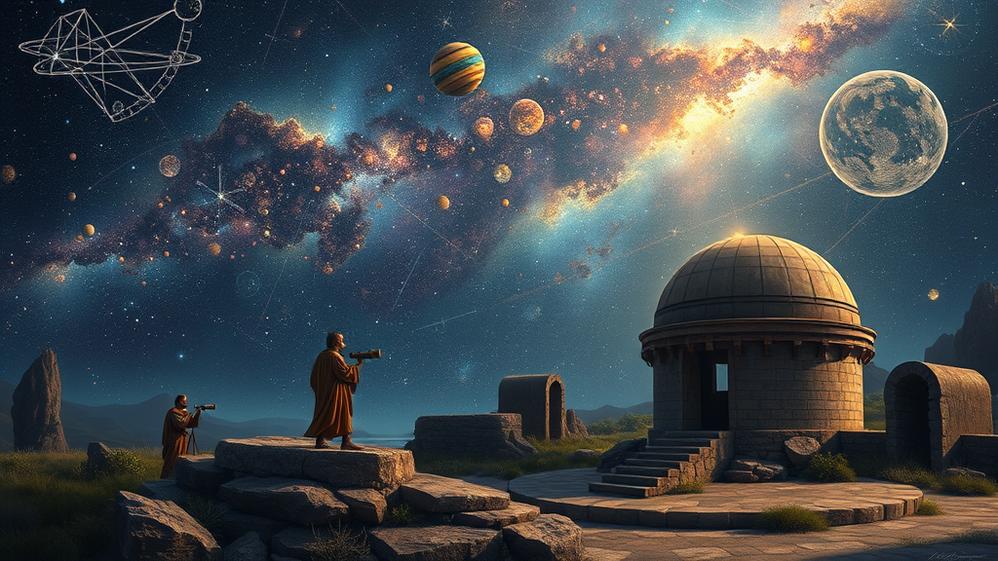
Ancient civilizations’ efforts to observe, record, and interpret celestial phenomena formed the foundation of modern astronomy. Systematic observations of the sky allowed early astronomers to build knowledge about the universe. Recognition of periodic motions and distinct celestial bodies paved the way for more advanced astronomical theories and practices.
How was astronomy studied in the ancient times?
Ancient civilizations studied astronomy through observations, recordings, and architectural alignments. Sun, moon, and stars were central to daily life. Mayans built elaborate calendars for celestial predictions. Buildings like temples and observatories aligned with astronomical events. Mesopotamian natives constructed ziggurats aligned with star risings. Astronomers used tools like sundials for accurate observations. Circular shapes represented celestial paths in instruments.
Observational methods included charting the sun and studying the moon. Ancient cultures analyzed moon phases, tracked celestial bodies, and documented movements to understand astronomy. Stephenson (1997) researched ancient astronomical records and eclipse documentation. Ancient Chinese astronomers recorded solar eclipses as early as 2134 BCE. Pang (2002) studied early Chinese astronomical observations and records.
Ancient cultures built structures and aligned stones for astronomical purposes. Ancient Egyptians built pyramids aligned with stars and constellations. Bauval (1994) researched Egyptian astronomical knowledge demonstrated through pyramid construction. Ancient Britons constructed Stonehenge to chart sun movements and track celestial bodies. Ruggles (1999) analyzed Stonehenge’s astronomical alignments.
Observatories and obelisks were used to study celestial bodies. Ancient Greeks built the Tower of the Winds observatory to study planet motions and document sky patterns. Gibbs (1976) analyzed the astronomical functions of the Tower of the Winds. Ancient Egyptians used obelisks to study sun and star movements. Shaw (2003) researched Egyptian obelisks and their astronomical significance.
Star maps were created to document celestial movements. Ancient cultures used stars for navigation during sea voyages and land exploration. Lewis (1994) investigated celestial navigation techniques in ancient cultures.
Practical applications of ancient astronomy included creating calendars and measuring time. Ancient cultures studied the moon and created calendars to measure time and track seasons. Aveni (2001) investigated ancient lunar studies and calendar creation. Ancient Mayans developed sophisticated calendars, including the 260-day Tzolkin calendar. Tedlock (1992) examined Mayan calendar systems and their astronomical basis.
Babylonians, Greeks, and Romans made significant contributions to astronomical understanding. Neugebauer (1975) studied astronomical advancements in ancient Babylonian, Greek, and Roman cultures.
What is the chronological timeline of astronomical discoveries?
The chronological timeline of astronomical discoveries is outlined below.
- Ancient civilizations: Early astronomical observations and theories about the cosmos. The Ptolemaic model places Earth at the center of the universe.
- 1543: Copernicus publishes “De revolutionibus orbium coelestium,” proposing a heliocentric model of the solar system.
- 1584: Bruno writes “On the Infinite Universe and Worlds,” suggesting an infinite universe with multiple worlds.
- 1609-1619: Kepler discovers three laws of planetary motion, describing the elliptical orbits of planets around the Sun.
- 1609: Galileo invents an improved telescope, making groundbreaking astronomical observations.
- 1610: Galileo observes the cratered surface of the Moon, the moons of Jupiter, and the phases of Venus.
- 1781: Discovery of Uranus.
- 1846: Discovery of Neptune.
- 1930: Discovery of Pluto. The field of astrophysics emerges with the development of spectroscopy.
- 1990: Hubble Space Telescope launches into orbit, revolutionizing astronomy with clear views from above Earth’s atmosphere.
Copernicus proposed heliocentrism in 1543. Giordano Bruno suggested infinite universe with multiple worlds in 1584. Galileo built his telescope in 1609, observing Jupiter’s moons in 1610. Kepler published planetary motion laws in 1619. Milky Way observations began in 1610. Hubble discovered galaxies beyond Milky Way in 1924.
Copernicus publishes his groundbreaking work “De revolutionibus orbium coelestium” in 1543. The book proposes a heliocentric model of the solar system, challenging the prevailing geocentric view.
Bruno writes “On the Infinite Universe and Worlds” in 1584. His ideas about an infinite universe with multiple worlds were considered heretical, leading to his execution by authorities.
Kepler discovers three laws of planetary motion between 1609 and 1619. These laws describe the elliptical orbits of planets around the Sun, revolutionizing our understanding of celestial mechanics.
Galileo invents an improved telescope in 1609. He uses this instrument to make groundbreaking astronomical observations, providing evidence for the Copernican heliocentric model.
Galileo observes the cratered surface of the Moon, the moons of Jupiter, and the phases of Venus in 1610. These discoveries further support the heliocentric model and challenge the geocentric view of the universe.
Astronomers discover new planets in the following centuries: Uranus in 1781, Neptune in 1846, and Pluto in 1930. The field of astrophysics emerges with the development of spectroscopy, allowing scientists to study the composition of celestial bodies.
Hubble launches into orbit in 1990, revolutionizing astronomy with its clear views from above Earth’s atmosphere. The space telescope enables unprecedented observations of distant galaxies, exoplanets, and cosmic phenomena.
Who first invented astronomy?
Mesopotamian civilization invented astronomy around 1000 BCE in modern-day Iraq. Mesopotamia is considered the cradle of astronomy. Mesopotamian astronomers made the first systematic and documented records of celestial observations. Astronomers built sophisticated observatories and created comprehensive catalogues like the Mul.Apin. Mesopotamians documented knowledge of celestial bodies, their motions, and periodic cycles.
Assyro-Babylonians advanced astronomical knowledge significantly. Assyro-Babylonians recorded detailed observations of the sun, moon, and planets on clay tablets around 1800 BCE. Babylonians studied and documented periodic motions of celestial bodies. Ancient Greek philosophers began systematic astronomical observations around 500 BCE. Aristarchus of Samos proposed the first known heliocentric model of the solar system between 310-230 BCE. Hipparchus of Rhodes made accurate measurements of celestial bodies’ positions and motions around 190-120 BCE. Hipparchus measured the Moon’s distance with 10% accuracy and determined the solar year length with 6-minute accuracy.
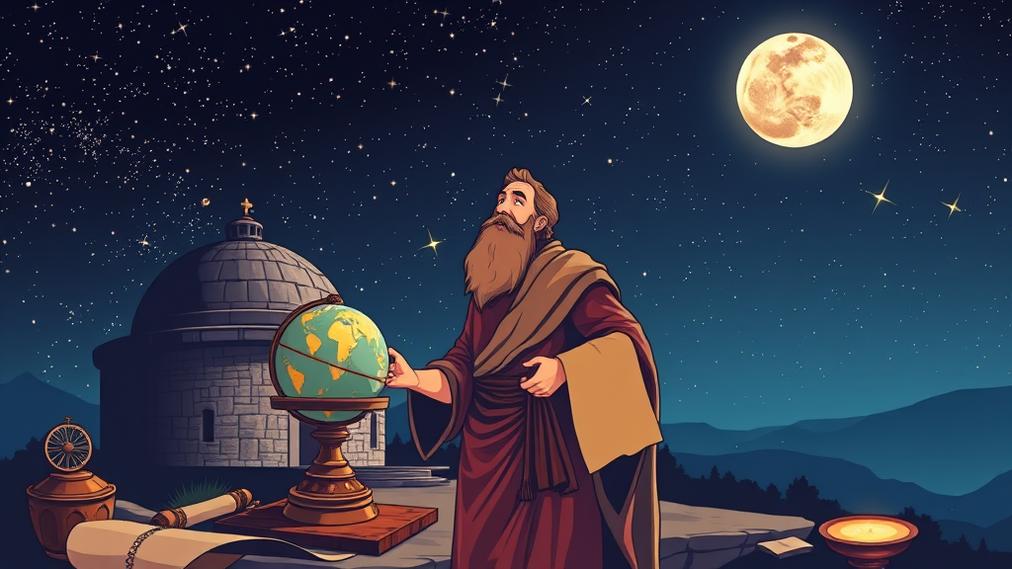
Astronomical knowledge developed over millennia through contributions from various cultures. Ancient civilizations like China, India, and Arabia contributed to the development of astronomical knowledge. Eratosthenes accurately measured Earth’s circumference and developed latitude and longitude systems between 276-194 BCE. Telescopes allowed more detailed night sky observations in the 17th century CE. Ancient Mesopotamian, Egyptian, Chinese, and Greek astronomers laid the foundations for modern astronomy.
Who invented astronomical charts?
Ancient Babylonians, Egyptians, and Greeks invented astronomical charts. Mesopotamians compiled the earliest known star catalogues around 2100 BC. Greek astronomer Hipparchus created the first comprehensive star catalogue (850 stars) around 190-120 BC. Kassite Babylonians contributed significantly, with their oldest catalogues dating to 1200 BC. Egyptian astronomer Ptolemy’s Almagest became one of history’s most influential star catalogues.
Ancient Egyptians created early astronomical charts around 2000 BCE. Egyptians inscribed these charts on tomb walls, depicting the night sky, constellations, and celestial bodies. Assyro-Babylonians observed and recorded celestial body movements around 700 BCE. They inscribed their observations on clay tablets, which included early forms of astronomical charts.
Hipparchus created one of the earliest comprehensive star catalogs around 190-120 BCE. He mapped positions of over 1,000 stars and identified several constellations still recognized today. Uranographers produced detailed charts of the night sky during the Renaissance period. Albrecht Dürer created a series of astronomical charts in the early 16th century.
Stabius contributed to the development of astronomical charts around 200-100 BCE. Heinfogel contributed to the creation of modern astronomical charts in the 19th century. Andreas Cellarius created elaborate astronomical charts in 1660. He published these charts in his book “Harmonia Macrocosmica,” depicting the night sky in exquisite detail.
Astronomical charts feature specific units for measurements. Degrees, minutes, and seconds of arc are used for declination. Hours, minutes, and seconds of right ascension are used for celestial coordinates. Astronomical units (AU) or parsecs (pc) are used for measuring celestial distances.
What tools were used in ancient astronomy?
The tools used in ancient astronomy are listed below.
- Sundials tracked the sun’s position to tell time, using shadows cast by vertical objects since 3500 BCE.
- Astrolabes solved time and celestial position problems, introduced around 150 BCE.
- Quadrants measured celestial altitudes above the horizon, in use since 1000 BCE.
- Sextants measured angles between celestial bodies and the horizon, developed around 1730 CE.
- Sticks for shadow casting estimated time using vertical objects since 3000 BCE.
- Bay instruments, made from palm fronds, measured celestial altitudes since 1000 CE.
- Al-Khujandi’s mural sextant, a fixed instrument, measured celestial altitudes with high precision in 10th century Persia.
- Zenith telescopes observed objects directly overhead, introduced around 1600 CE.
- Triquetrum measured altitudes of celestial bodies and determined local time since 1000 CE.
- Compass dials determined direction using rotating bezels and magnetic needles since 1200 CE.
- Navicula, a portable astrolabe, aided navigation since 1000 CE.
- Warren Field calendar tracked lunar cycles and seasons in Neolithic Scotland, dating back to 8000 BCE.
- Astronomical mechanical clocks displayed celestial positions and time since 1200 CE.
- Armillary spheres demonstrated celestial relationships using sphere models since 1000 CE.
- Astrariums demonstrated celestial motions mechanically since 1300 CE.
- Planetariums demonstrated solar system movements on a large scale since 1500 CE.
- Volvelles calculated celestial positions using rotating disks since 1200 CE.
- Zodiac man diagrams illustrated zodiac-body relationships since 1500 CE.
- Stonehenge tracked celestial movements as a prehistoric monument since 3000 BCE.
- Sight-lines tracked celestial movements using stone alignments since 2000 BCE.
- Nebra sky disk depicted the night sky with gold inlays representing celestial bodies, dating back to 1600 BCE.
Ancient astronomical tools included sundials, astrolabes, quadrants, and sextants. Sundials measured time since 3500 BCE. Greeks developed astrolabes around 150 BCE for celestial positioning. Quadrants measured celestial altitudes from ancient Greece through the Middle Ages. Sextants, developed in the 15th century CE, measured angles between celestial objects. Armillary spheres, celestial globes, and observatories supplemented these instruments.
Shadow-based instruments were fundamental in early astronomy. Sticks for shadow casting estimated time using vertical objects since 3000 BCE. Bay instruments, made from palm fronds, measured celestial altitudes since 1000 CE. Al-Khujandi’s mural sextant, a fixed instrument, measured celestial altitudes with high precision in 10th century Persia.
Specialized tools aided in celestial observations. Zenith telescopes observed objects directly overhead, introduced around 1600 CE. Triquetrum measured altitudes of celestial bodies and determined local time since 1000 CE. Compass dials determined direction using rotating bezels and magnetic needles since 1200 CE. Navicula, a portable astrolabe, aided navigation since 1000 CE.
Time-keeping devices evolved alongside observational tools. Warren Field calendar tracked lunar cycles and seasons in Neolithic Scotland, dating back to 8000 BCE. Astronomical mechanical clocks displayed celestial positions and time since 1200 CE.
Celestial models and representations enhanced understanding of the cosmos. Armillary spheres demonstrated celestial relationships using sphere models since 1000 CE. Astrariums demonstrated celestial motions mechanically since 1300 CE. Planetariums demonstrated solar system movements on a large scale since 1500 CE. Volvelles calculated celestial positions using rotating disks since 1200 CE. Zodiac man diagrams illustrated zodiac-body relationships since 1500 CE.
Ancient astronomical structures played a crucial role in early observations. Stonehenge tracked celestial movements as a prehistoric monument since 3000 BCE. Sight-lines tracked celestial movements using stone alignments since 2000 BCE.
Artifacts provided insights into ancient astronomical knowledge. Nebra sky disk depicted the night sky with gold inlays representing celestial bodies, dating back to 1600 BCE.
What was ancient astronomy in Mesopotamia?
Ancient Mesopotamian astronomy was a sophisticated system of celestial observation and recording. Babylonians, known as Chaldeans, developed mathematical calculations for predicting celestial events. Skilled astronomers studied sun, moon, and planetary movements across the skies. Astrologers interpreted celestial phenomena to forecast earthly occurrences. Babylonian culture integrated astronomy into history and daily life.
Mesopotamians used the sexagesimal system to simplify calculations of celestial movements. They developed mathematical astronomy using arithmetic and geometric methods. Astronomical texts like the “Mul.Apin” series were written to document their observations and predictions. Mesopotamians invented the twelve-month calendar based on lunar cycles, demonstrating their advanced understanding of celestial patterns.
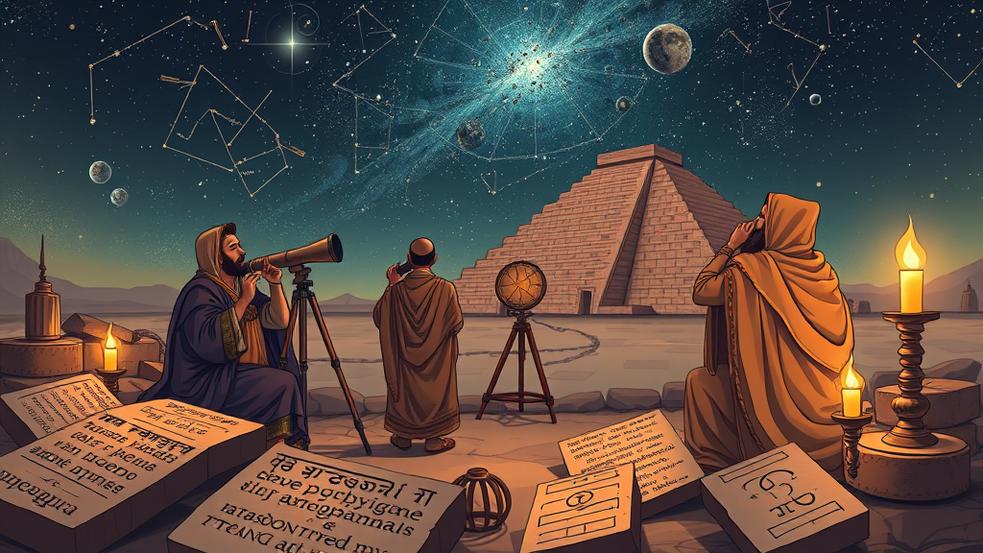
Mesopotamians tied gods to planets in their belief system. They practiced celestial divination to interpret omens and maintain cosmic order. The planet Venus was associated with the goddess Ishtar, reflecting the deep connection between astronomy and religion in Mesopotamian culture.
Mesopotamia are considered pioneers of systematic astronomy. Their astronomical heritage influenced later civilizations, laying foundations for Greek and Islamic astronomy. Mesopotamia have left a lasting legacy in the field of astronomy, with observations recorded on clay tablets dating back to 2000 BCE.
What are the ancient astronomical discoveries in Mesopotamia?
The ancient astronomical discoveries in Mesopotamia are listed below.
- Division of the circle into 360 degrees by Mesopotamian mathematicians.
- Babylonian astronomers divided each day into 12 kaspu for precise timekeeping.
- Development of the solar kaspu concept to account for variations in daylight throughout the year.
- Systematic recording of celestial observations on clay tablets.
- Study of the five visible planets: Mercury, Venus, Mars, Jupiter, and Saturn by ancient Babylonians.
- Observation of the moon, sun, and stars for timekeeping and agricultural purposes by Sumerian astronomers.
- Development of the sexagesimal numeral system for precise astronomical calculations.
- Creation of astronomical diaries to record celestial events and weather patterns.
- Naming of constellations after mythological figures and gods, such as the “Hired Man” (Orion) and “She-Goat” (Lyra).
- Detailed observation and recording of the phases and movements of Venus by Sumerian astronomers.
- Development of a predictive approach to forecast celestial events.
- Achievement of mathematical precision in astronomical calculations through arithmetic and geometry.
- Mesopotamia considered the cradle of astronomy due to significant contributions that laid foundations for later Greek discoveries.
Babylonian astronomers made significant contributions to astronomy. Babylonians divided the circle into 360 degrees and the year into 12 lunar cycles. Babylonians recognized the sun’s importance in the solar system. Babylonians cataloged over 36 constellations, many still known today. Babylonians developed a sophisticated understanding of sun movements and astronomical tables. Babylonians divided the day into 24 equal hour periods.
Systematic recording of celestial observations on clay tablets was a hallmark of Mesopotamian astronomy. Ancient Babylonians studied all five visible planets: Mercury, Venus, Mars, Jupiter, and Saturn. Sumerian astronomers observed the moon, sun, and stars for timekeeping and agricultural purposes. The development of the sexagesimal numeral system by Mesopotamian mathematicians allowed for precise astronomical calculations.
Babylonian astronomers created astronomical diaries to record celestial events and weather patterns. Ancient Mesopotamians named constellations after mythological figures and gods, including the “Hired Man” (Orion) and “She-Goat” (Lyra). Sumerian astronomers observed and recorded the phases and movements of Venus with great detail.
Babylonian astronomers developed a predictive approach to forecast celestial events. Mathematical precision in astronomical calculations was achieved through the use of arithmetic and geometry. Mesopotamia is considered the cradle of astronomy due to these significant contributions, which laid the foundations for later Greek astronomical discoveries.
What was ancient astronomy in Rome?
Ancient Roman astronomy recognized seven celestial bodies in the sky. Romans gave names of Roman gods to these bodies: Sol (Sun), Luna (Moon), Mercury, Mars, Jupiter, Saturn, and Venus. Celestial bodies played a crucial role in Roman mythology and astrology. Romans developed a system to interpret planetary movements and predict effects on human life.
Romans utilized astronomy for practical purposes across their vast empire. Astronomical knowledge guided navigation across 5.9 million square miles of Roman territory and 250,000 miles of roads. Romans applied celestial observations to determine agricultural timing and predict weather patterns. They created calendars based on astronomical knowledge and used celestial alignments in constructing temples and buildings like the Pantheon.
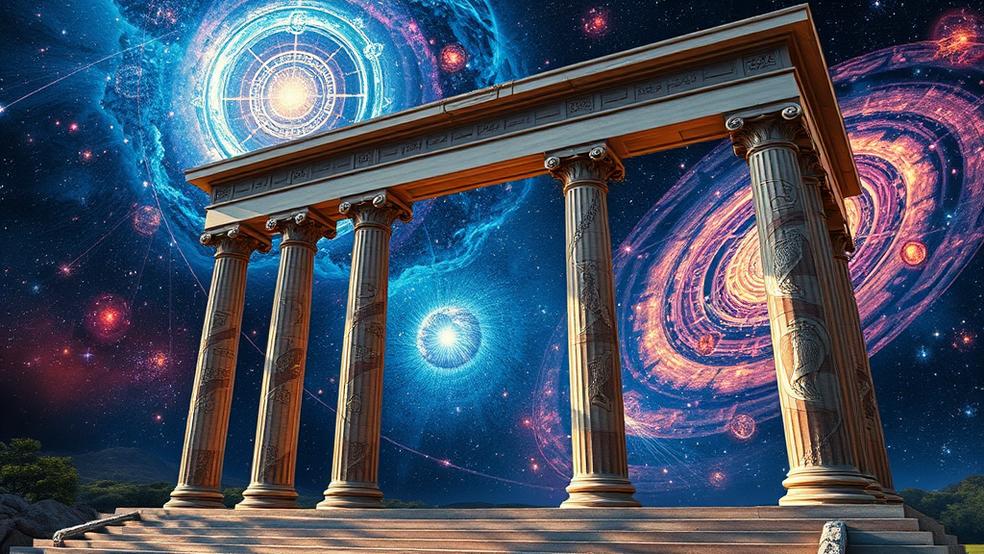
Astronomy held significant cultural and religious importance in Roman society. Romans believed celestial bodies influenced human affairs and consulted astrologers to interpret celestial signs. They accepted Ptolemy’s geocentric model of the universe, which placed Earth at the center. Roman Emperor Augustus built an observatory in Rome to enhance celestial predictions. Ptolemy, a Roman astronomer, accurately estimated the Earth-Moon distance. Romans divided the zodiac into 12 segments for astrological purposes, further integrating astronomy into their daily lives and decision-making processes.
What are the ancient astronomical discoveries in Rome?
The ancient astronomical discoveries in Rome are listed below.
- Ancient Roman astronomers observed seven celestial bodies: Sol (Sun), Luna (Moon), Mercury, Venus, Mars, Jupiter, and Saturn.
- They charted the motions of planets and the phases of the Moon.
- Ptolemy developed a geocentric model of the universe described in his work “Almagest”.
- Romans estimated distances between Earth and celestial bodies; Ptolemy calculated the Moon’s distance at 38 times Earth’s radius, and Lucius Tarutius Firmanus estimated the Sun’s distance at 120 times Earth’s radius.
- Celestial events were culturally significant; Romans believed comets and planetary alignments influenced human affairs.
- Seneca described the aurora borealis in his work “Naturales Quaestiones”.
- Rome built observatories, sundials, and designed the Pantheon with astronomical alignments to support their studies.
- They used water clocks and armillary spheres for precise astronomical observations.
- Pliny the Elder recorded lunar eclipses and noted the Moon’s orbital tilt of 5 degrees.
- Romans identified Mercury as the closest planet to the Sun with an orbital period of 88 Earth days.
- They recognized Venus as the brightest planet with an orbital period of 225 Earth days.
- Mars was identified by its reddish color and observed to have an orbital period of 687 Earth days.
- Jupiter was known as the largest planet with an orbital period of 12 Earth years.
- Saturn was identified as the ringed planet with an orbital period of 29.5 Earth years.
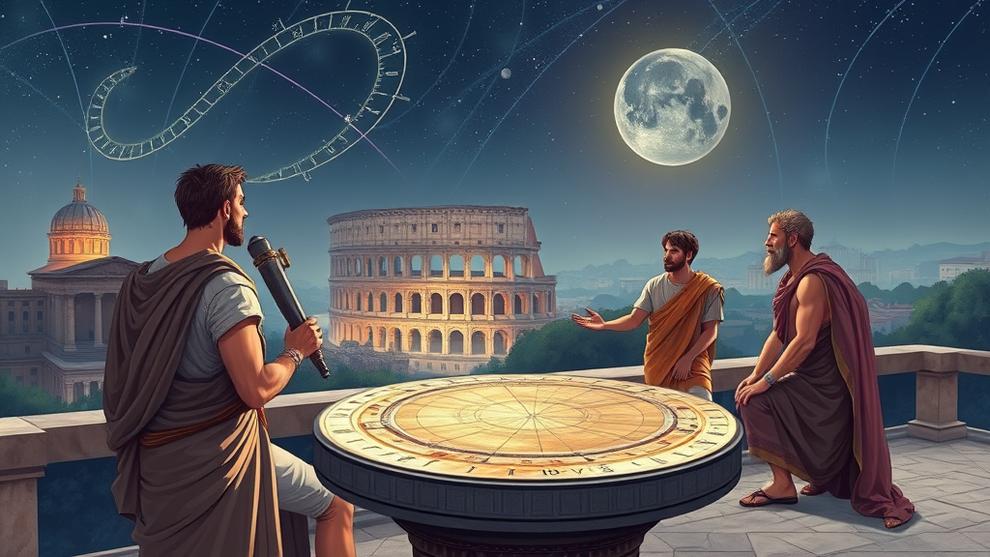
Romans discovered seven celestial bodies: Mercury, Venus, Mars, Jupiter, Saturn, Luna (Moon), and Sol (Sun). Ptolemy observed Venus’ phases. Galen identified Jupiter’s four largest moons. Pappus described Saturn’s rings. Hipparchus noted Mars’ retrograde motion. Pliny studied lunar cycles. Romans created detailed sky maps for navigation and research.
Roman astronomers charted planet motions and lunar phases. Ptolemy developed a geocentric model of the universe in his influential work “Almagest”. Romans estimated distances between Earth and celestial bodies. Ptolemy calculated the Moon’s distance to be 38 times Earth’s radius. Lucius Tarutius Firmanus estimated the Sun’s distance to be 120 times Earth’s radius.
Celestial events held great importance in Roman culture. Romans looked to the heavens for omens and divine insights. Comets and planetary alignments were believed to influence human affairs. Seneca described the aurora borealis in his work “Naturales Quaestiones”.
Rome established astronomical infrastructure to support their studies. Romans erected observatories and created sundials to track astronomical events. The Pantheon was designed with specific astronomical alignments. Water clocks and armillary spheres were used for precise observations.
Roman astronomers made systematic observations of celestial bodies. Pliny the Elder recorded lunar eclipses and noted the Moon’s orbital tilt of 5 degrees. Romans identified Mercury as the closest planet to the Sun with an orbital period of 88 Earth days. Venus was recognized as the brightest planet with an orbital period of 225 Earth days. Mars was identified by its reddish color and observed to have an orbital period of 687 Earth days. Jupiter was known as the largest planet with an orbital period of 12 Earth years. Saturn was identified as the ringed planet with an orbital period of 29.5 Earth years.
What was ancient astronomy in China?
Ancient Chinese astronomy originated in the Shang Dynasty. Chinese astronomers developed sophisticated observation and prediction systems. Traditional framework divided the sky into three enclosures and 28 mansions. ‘Li’ system measured celestial distances, equaling 576 kilometers. Astronomers recorded eclipses, lunar and solar phenomena. Complex computing methods predicted events accurately. Astronomical knowledge influenced Chinese culture and philosophy.
Observational practices in ancient Chinese astronomy were sophisticated and systematic. Astronomers recorded observations of eclipses, alignments, and comets with great precision. Chinese astronomers built observatories to facilitate celestial observations and used jade instruments like armillary spheres for measurements. The equatorial system was developed by Chinese astronomers for more precise measurements of celestial bodies.
Ancient Chinese astronomy covered various areas of focus. Astronomers tracked celestial events including eclipses and planetary alignments. Star catalogs were created to document celestial bodies, with Shi Shen producing one of China’s earliest catalogs in the 4th century BCE. Comets were observed and classified as omens, while guest stars (now known as supernovae) were recorded when they appeared. The celestial equator was studied to understand celestial movements.
Theoretical developments in ancient Chinese astronomy were significant. Cosmological schemes were developed to explain the structure and workings of the universe. Astronomical achievements were made in creating comprehensive catalogs and accurately predicting celestial events. Notable astronomers like Gan De observed Jupiter and its moons in the 4th century BCE, while Zhang Heng invented the seismograph and contributed to astronomy in the 2nd century CE.
What are the ancient astronomical discoveries in China?
The ancient astronomical discoveries in China are listed below.
- Ancient Chinese astronomers recorded 1,600 solar eclipses and 1,000 lunar eclipses between 2137 BCE and 1621 CE.
- The earliest recorded solar eclipse dates back to 2137 BCE during the Xia Dynasty.
- Sunspots were observed as early as 28 BCE during the Han Dynasty.
- Chinese astronomers recognized the periodic nature of sunspots and associated them with weather changes.
- Over 1,000 comet observations were recorded, with the earliest dating back to 613 BCE.
- Halley’s Comet was observed and recorded in 240 BCE, 87 CE, and 760 CE.
- Meteors and fireballs were documented, with a large fireball observed over Luoyang in 116 CE.
- A spectacular meteor shower in 687 CE was described as a “rain of stars.”
- Guest stars, including novae and supernovae, were extensively cataloged.
- The supernova of 185 CE was visible for 12 months and is considered the first observed supernova in history.
- The supernova observation in 1054 CE is now known as the Crab Nebula.
- Planetary events were recorded, including a conjunction of five planets in 105 CE.
- Aurora borealis was observed as early as 2600 BCE and called “heavenly lights” or “spectral lights.”
- Circumpolar stars were identified for navigation and timekeeping purposes.
- Chinese astronomers developed a system to predict eclipses using the “eclipse cycle” of 135 months.
- They recognized the 18-year, 11-day Saros cycle for eclipse prediction.
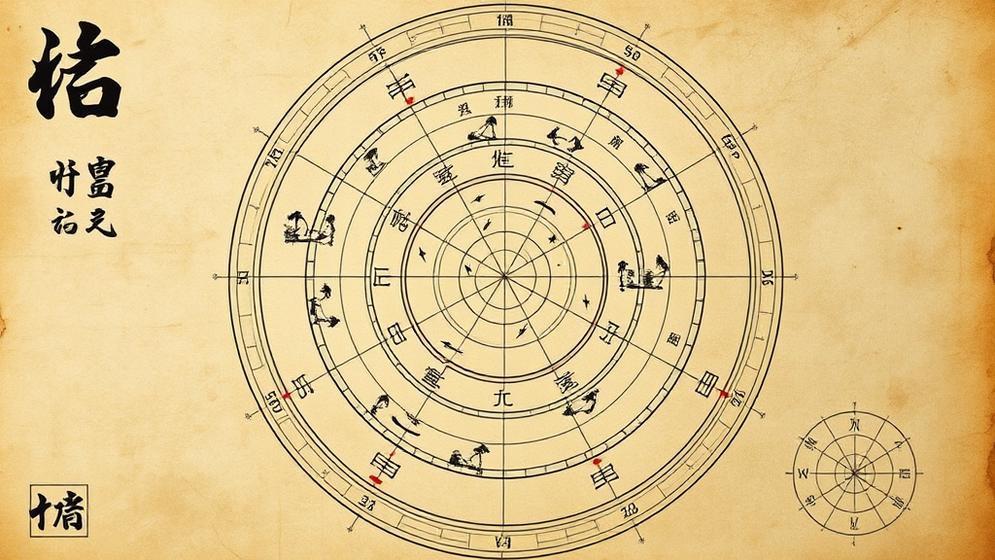
Ancient Chinese astronomers recorded aurora borealis in 2600 BC. Solar eclipses were documented, including the 2136 BC event. Comets were observed, like the 1059 BC “broom star” and 240 BC comet. Supernovae were noted, such as the 1054 AD “guest star” (Crab Nebula). Lunar eclipses were tracked, including the 28 BC event.
Comets played a crucial role in Chinese astronomical discoveries. Chinese astronomers recorded over 1,000 comet observations, with the earliest dating back to 613 BCE. Halley’s Comet was observed and recorded in 240 BCE, 87 CE, and 760 CE. Meteors and fireballs were documented, with Chinese astronomers referring to meteors as “falling stars.” A large fireball was observed over Luoyang in 116 CE, and a spectacular meteor shower in 687 CE was described as a “rain of stars.”
Guest stars, which include novae and supernovae, were extensively cataloged by Chinese astronomers. The supernova of 185 CE was visible for 12 months and is considered the first observed supernova in history. Another notable supernova observation occurred in 1054 CE, now known as the Crab Nebula. Planetary events were recorded, including a conjunction of five planets in 105 CE.
Aurora borealis, called “heavenly lights” or “spectral lights” by Chinese astronomers, was observed as early as 2600 BCE. Circumpolar stars were identified for navigation and timekeeping purposes. Chinese astronomers developed a system to predict eclipses using the “eclipse cycle” of 135 months and recognized the 18-year, 11-day Saros cycle for eclipse prediction.
What was ancient astronomy in India?
Ancient Indian astronomy dates back to 4000 BCE. Indian civilization made significant contributions to celestial studies. Sages developed sophisticated systems recorded in Vedas and Puranas. Astronomers accurately predicted solstices, monsoons, and planetary movements. Multiple moons were recognized. Astronomy served practical and spiritual purposes, closely tied to astrology. Indian astronomical knowledge was advanced for its time.
Indian astronomers studied natural divisions of time, including day, month, and year. They created calendars based on lunar and solar cycles for practical use. Ancient Indians built observatories to observe and record celestial movements. The Jantar Mantar in Jaipur, built in 1734 CE, features massive stone instruments for astronomical measurements.
Astronomy in ancient India was closely linked with astrology. Astronomers created astrological charts to track celestial movements and forecast horoscopes. They read omens from celestial events to predict future occurrences. Ancient Indians devised mathematical models to understand and predict celestial body movements. Aryabhata (476 CE) calculated celestial distances and sizes of the sun, moon, and earth with remarkable accuracy. He proposed a heliocentric model of the solar system, demonstrating advanced astronomical understanding.
What are the ancient astronomical discoveries in India?
The ancient astronomical discoveries in India are listed below.
- The Indus Valley Civilization recorded astronomical events on seals and tablets around 4000 BCE.
- Earth was recognized as a sphere in ancient Indian cosmology, described in the Rigveda around 1500 BCE.
- Aryabhata elaborated on the concept of Earth’s spherical shape in his book “Aryabhatiya” in 476 CE.
- Aryabhata calculated Earth’s circumference to be approximately 39,692 kilometers in the 5th century CE.
- Aryabhata identified Earth’s rotation as the cause of day and night, determining its direction to be west to east.
- Varahamihira recognized the Sun as a star in 505 CE.
- Ancient Indian astronomers identified five planets in the solar system: Mercury, Venus, Mars, Jupiter, and Saturn.
- They developed sophisticated mathematical models to describe the motions of celestial bodies, incorporating trigonometry and algebra.
- The Surya Siddhanta presented a heliocentric model with nine planets in 400 CE.
- Observational astronomy was crucial, with the Mahabharata describing a solar eclipse around 4000 BCE.
- Ancient Indians observed the Tropic of Cancer, noting the Sun’s changing path across the sky.
- Bhaskara made detailed observations of the Tropic of Cancer in 1114 CE.
- Astronomy was intertwined with ancient Indian culture and religion, including Sun and star deification.
- The Rigveda described constellations like Orion (Mrigashira) and the star Sirius (Lubdhaka).
- Ancient Indians created astrological charts called “janam patrika” to predict celestial body positions.
- Omens reading was practiced, interpreting celestial events to predict future occurrences.
- Ancient Indian scholars developed the concept of zero and the decimal system for astronomical calculations.
Indian astronomers made groundbreaking discoveries millennia ago. Aryabhatta propounded Earth’s spherical shape in the 5th century, estimating its circumference at 40,008 km. Brahmagupta theorized Earth’s rotation in the 7th century. Ancient texts like Rigveda (1500 BCE) and Vedanga Jyotisha (1200 BCE) contain 5000-year-old astronomical observations. Yojanas measured cosmic distances.
Aryabhata made several groundbreaking discoveries in the 5th century CE. He calculated Earth’s circumference to be 39,692 kilometers, a remarkably accurate estimation for his time. Aryabhata correctly identified Earth’s rotation as the cause of day and night, determining its direction to be west to east. Varahamihira recognized the Sun as a star in 505 CE, advancing understanding of celestial bodies.
Ancient Indian astronomers identified five planets in the solar system: Mercury, Venus, Mars, Jupiter, and Saturn. They developed sophisticated mathematical models to describe celestial body motions, incorporating trigonometry and algebra. The Surya Siddhanta presented a heliocentric model with nine planets in 400 CE, demonstrating advanced astronomical knowledge.
Observational astronomy played a crucial role in ancient Indian discoveries. The Mahabharata described a solar eclipse occurring around 4000 BCE. Ancient Indians observed the Tropic of Cancer, noting the Sun’s changing path across the sky. Bhaskara made detailed observations of the Tropic of Cancer in 1114 CE.
Astronomy was deeply intertwined with ancient Indian culture and religion. Sun deification was practiced, with the Sun worshipped as the deity Surya. Star deification was common, with constellations mentioned in the Rigveda. The Rigveda described the constellation Orion as Mrigashira and the star Sirius as Lubdhaka.
Ancient Indians developed practical applications for their astronomical knowledge. They created astrological charts called “janam patrika” to predict celestial body positions. Omens reading was practiced, interpreting celestial events to predict future occurrences. Ancient Indian scholars developed the concept of zero and the decimal system for astronomical calculations, significantly advancing mathematical astronomy.
What is Hellenistic astronomy?
Hellenistic astronomy science flourished from 3rd century BCE to 1st century CE. Renowned scholars like Aristarchus, Eratosthenes, and Hipparchus made groundbreaking discoveries. Aristarchus proposed the heliocentric model around 280 BCE. Eratosthenes calculated Earth’s circumference to be approximately 40,000 km. Hellenistic astronomers developed trigonometry, astronomical tables, and comprehensive solar system models, shaping astronomy for centuries.
Intellectual culture of the Hellenistic period encouraged the popularization of astronomy among the general public. Astronomers made substantial contributions to physics, studying floating bodies and developing the concept of specific gravity. Engineers advanced the principles of levers and pulleys during this time, as documented by Drachmann (1963). Astrologers introduced the concept of zodiac degrees, assigning specific degrees to each zodiac sign, a practice that remains essential in Western astrology today.
Notable figures in Hellenistic astronomy included Hipparchus and Aristarchus of Samos. Hipparchus became famous for measuring the solar year and discovering the equinoxes, as documented by Toomer (1984). Aristarchus proposed the first known heliocentric model of the solar system, which was studied by Heath (1913). These astronomers’ work laid the foundation for more sophisticated astronomical systems and influenced later scientific discoveries.
What are the achievements of Hellenistic astronomy?
The achievements of Hellenistic astronomy are listed below.
- Hellenistic astronomy made significant advancements in understanding celestial motions.
- Astronomers developed models to explain planetary movements.
- The concept of the celestial sphere was introduced.
- Mathematical astronomy saw great progress during this period.
- Hipparchus and Ptolemy used geometric and trigonometric methods to calculate celestial motions with unprecedented accuracy.
- Aristarchus calculated the Moon’s size to be about 1/3 of Earth’s size, approximately 2,500 miles in diameter.
- Eratosthenes measured Earth’s circumference with remarkable precision, estimating it to be about 40,000 km.
- Hellenistic astronomers observed planets and studied their motions systematically.
- Hipparchus cataloged over 1,000 stars, creating the first comprehensive star catalog.
- Technological improvements enhanced astronomical observations.
- Hellenistic astronomers developed advanced instruments like the armillary sphere and astrolabe.
- The astrolabe, created by Hipparchus, calculated celestial positions and predicted celestial events.
- Hellenistic inventors created sophisticated calculating devices such as the Antikythera Mechanism.
- Hellenistic astronomy laid the foundation for future astronomical studies.
- Astronomers transformed descriptive astronomy into a quantitative and predictive science.
- Mathematical models were developed to describe celestial motions using epicycles and deferents.
- These models allowed astronomers to predict celestial events like lunar and solar eclipses with improved accuracy.
- Hellenistic achievements in astronomy marked a significant turning point in the field’s development, influencing astronomical thought until the Scientific Revolution.
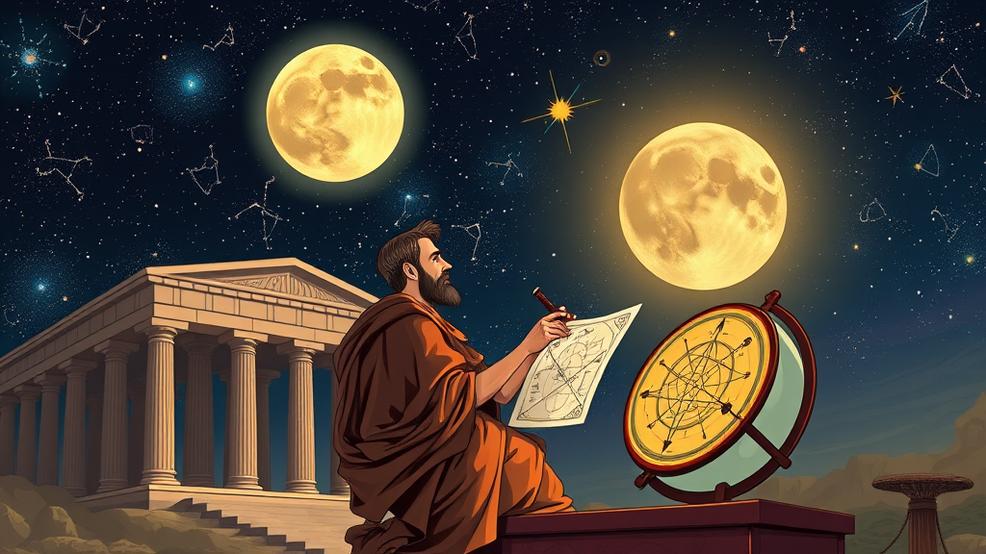
Hellenistic astronomy spanned 300 BCE to 300 CE. Greeks made major advancements in understanding the universe. Hipparchus created a 1,000-star catalog and invented the astrolabe. Ptolemy developed the geocentric model with epicycles and eccentrics. Astronomers improved observational techniques, developed trigonometry, and influenced later scientific developments like Copernicus and Galileo’s work.
Observational and measurement accomplishments were remarkable in Hellenistic astronomy. Aristarchus calculated the Moon’s size to be about 1/3 of Earth’s size, approximately 2,500 miles in diameter. Eratosthenes measured Earth’s circumference with remarkable precision, estimating it to be about 40,000 km. Hellenistic astronomers observed planets and studied their motions systematically. Hipparchus cataloged over 1,000 stars, creating the first comprehensive star catalog.
Technological improvements enhanced astronomical observations. Hellenistic astronomers developed advanced instruments like the armillary sphere and astrolabe. The astrolabe, created by Hipparchus, calculated celestial positions and predicted celestial events. Hellenistic inventors created sophisticated calculating devices such as the Antikythera Mechanism.
Hellenistic astronomy laid the foundation for future astronomical studies. Astronomers transformed descriptive astronomy into a quantitative and predictive science. Mathematical models were developed to describe celestial motions using epicycles and deferents. These models allowed astronomers to predict celestial events like lunar and solar eclipses with improved accuracy. Hellenistic achievements in astronomy marked a significant turning point in the field’s development, influencing astronomical thought until the Scientific Revolution.
What is renaissance astronomy?
Renaissance astronomy encompassed much development in astronomical knowledge, instrumentation, and mathematical techniques from the 14th to 17th century. Geocentric model dominated initially. Solar-centric view proposed by Copernicus challenged existing beliefs. Astronomers like Tycho Brahe and Johannes Kepler advanced the field. Modern astronomy emerged from these Renaissance advancements, fundamentally shifting our understanding of the universe.
Technological advancements revolutionized astronomy study during the Renaissance. Hans Lippershey invented the telescope in 1608. Galileo Galilei utilized the telescope to explore the universe, making significant discoveries. Galileo observed four moons orbiting Jupiter and the phases of Venus. These observations provided evidence for the Copernican heliocentric model. The heliocentric model explained retrograde motion elegantly, which had challenged the geocentric model.
Scientific advances facilitated a shift in understanding the cosmos. Tycho Brahe made precise measurements of planetary positions. Johannes Kepler developed three laws of planetary motion using Brahe’s data between 1609 and 1619. Kepler described the paths of planets as elliptical orbits around the Sun. Renaissance astronomers developed the idea of the universe as infinite and explored the concept of the “music of the spheres.”
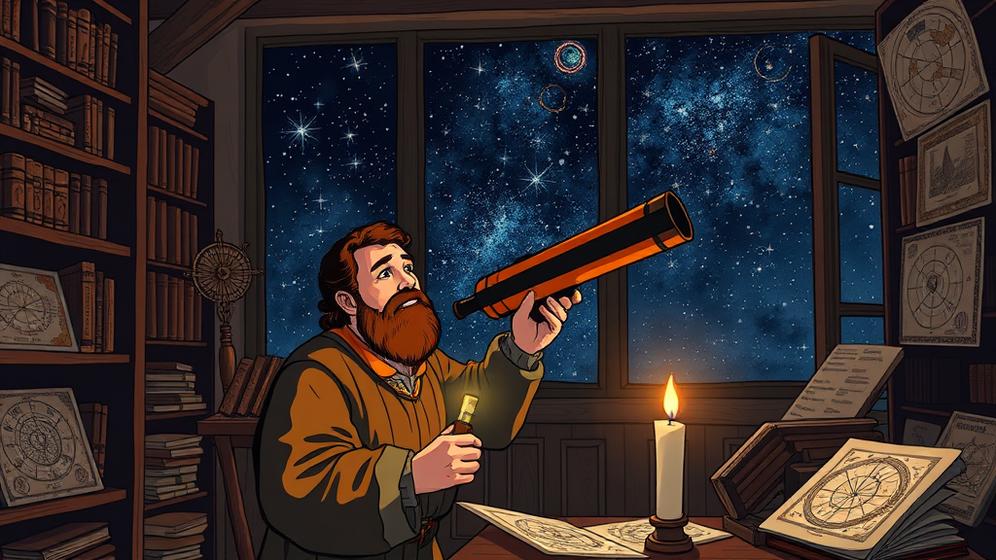
Renaissance astronomy study awakened a new era of astronomical inquiry. Scientists developed and tested new astronomical theories through observations. The willingness to challenge traditional views led to a significant turning point in astronomy. Astronomers transitioned from a geocentric to a heliocentric understanding of the universe. Renaissance astronomy laid the foundation for future breakthroughs and continues to influence our understanding of the universe today.
What are the famous astronomers in the history of astronomy?
The famous astronomers in the history of astronomy are listed below.
- Eratosthenes of Cyrene
- Claudius Ptolemy
- Abd al-Rahman al-Sufi
- Nicolas Copernicus
- Galileo Galilei
- Johannes Kepler
- Christiaan Huygens
- Giovanni Cassini
- Isaac Newton
- Edmond Halley
- Charles Messier
- William Herschel
- Johann Gottfried Galle
- Edwin Hubble
- Clyde William Tombaugh
- Cecilia Payne-Gaposchkin
- Albert Einstein
- Carl Sagan
- Stephen Hawking
Edwin P. Hubble discovered galaxies beyond the Milky Way and the universe’s expansion. Copernicus proposed the heliocentric model. Kepler discovered planetary motion laws. Galilei observed heavens with telescopes. Herschel discovered Uranus. Halley calculated comet orbits. Huygens discovered Saturn’s moon Titan. Galle discovered Neptune. Powell contributed to 19th-century astronomy.
Nicolas Copernicus proposed the revolutionary heliocentric model of the universe in the Renaissance era. Galileo Galilei provided evidence for the Copernican model through his pioneering telescope observations. Johannes Kepler discovered the three laws of planetary motion, describing the paths of planets around the Sun. Christiaan Huygens discovered Saturn’s rings and its largest moon, Titan. Giovanni Cassini discovered four moons of Saturn and the gap in Saturn’s rings that bears his name. Isaac Newton developed the laws of motion and universal gravitation, laying the foundation for classical mechanics. Edmond Halley predicted the return of Halley’s Comet, which now bears his name.
Charles Messier cataloged many deep-sky objects, including nebulae and star clusters, in the 18th century. William Herschel discovered Uranus, the first planet to be discovered using a telescope. Johann Gottfried Galle discovered Neptune, the eighth planet in our solar system.
Edwin Hubble observed the expansion of the universe in the 20th century, leading to the Big Bang theory. Clyde William Tombaugh discovered Pluto, now classified as a dwarf planet. Cecilia Payne-Gaposchkin made significant contributions to understanding stellar composition and evolution. Albert Einstein developed the theory of general relativity, revolutionizing our understanding of space and time. Carl Sagan popularized astronomy and promoted the search for extraterrestrial intelligence. Stephen Hawking contributed to understanding black holes and theories about the origin of the universe.
How did ancient astronomers explore space and stars?
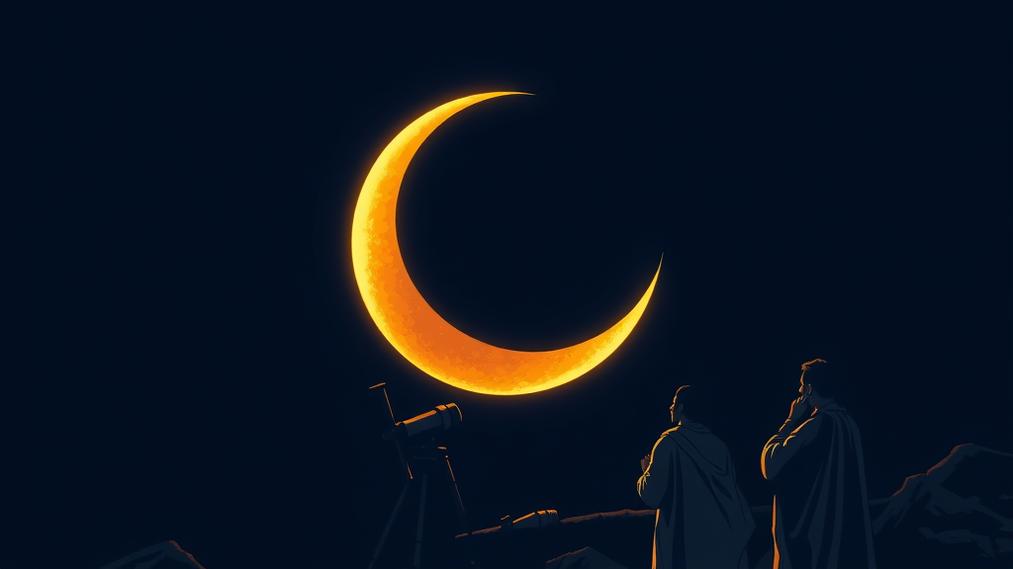
Ancient astronomers explored space and stars through meticulous observation and measurement techniques. Astronomers observed the night sky for extended periods, tracking celestial cycles and monitoring planet motions against background stars. Star catalogues were created, listing stars and their characteristics, with notable examples including the “Three Stars Each” catalogue from Mesopotamia and Hipparchus’ comprehensive star catalogue in ancient Greece.
Celestial object positions were measured using tools like astrolabes in ancient Greece. Astronomers tracked star positions relative to other celestial bodies and created detailed star maps showing celestial object positions. The heavens were mapped using celestial observations, resulting in astronomical tables to record celestial data. Ptolemy’s Almagest, a comprehensive astronomy treatise, contained over 1,000 stars.
Time measurement relied heavily on celestial observations. Ancient civilizations developed calendars based on celestial cycles, such as the Babylonian lunisolar calendar combining moon and sun cycles. Moon phases were studied to understand lunar cycles, while sun motion observations helped comprehend seasonal changes. Star rising times were tracked to mark seasonal shifts.
Prediction of celestial events became possible through observed patterns. Eclipses were predicted by studying celestial patterns, with Liu Xin successfully predicting a solar eclipse in 181 BCE in ancient China. Planet movements were observed to predict alignments. Astronomers differentiated planets from stars by their unique characteristics and motions.
How did ancient astronomers distinguish planets from stars?
Ancient astronomers distinguished planets from stars through careful observation. Greeks noticed celestial bodies wandered across the sky while others remained fixed. Wandering bodies were identified as planets. Stars appeared fixed, forming unchanging constellations. Planets moved through star patterns at different rates. Mercury and Venus moved rapidly, while Jupiter and Saturn moved slowly across the sky.
Planets exhibit irregular motions, including retrograde movement where they appear to temporarily reverse direction. Ancient stargazers tracked planetary paths against the backdrop of fixed constellations over extended periods. Changes in planetary brightness were noted as they moved through different positions relative to Earth.
Long-term monitoring allowed ancient astronomers to map the irregular paths of planets. Mercury, Venus, Mars, Jupiter, and Saturn were identified as visible planets by early observers. Aristotle and Eratosthenes recognized planets as distinct from stars in ancient Greek astronomy. Ptolemy developed the geocentric model of the universe based on these observations in classical astronomy.
Ancient astronomical methods laid the foundation for later discoveries in astronomy. Aristarchus of Samos proposed the first known heliocentric model of the solar system. Eratosthenes of Cyrene measured Earth’s circumference and developed the concepts of latitude and longitude. Hipparchus of Rhodes discovered equinoxes, solstices, and calculated the length of the solar year.

